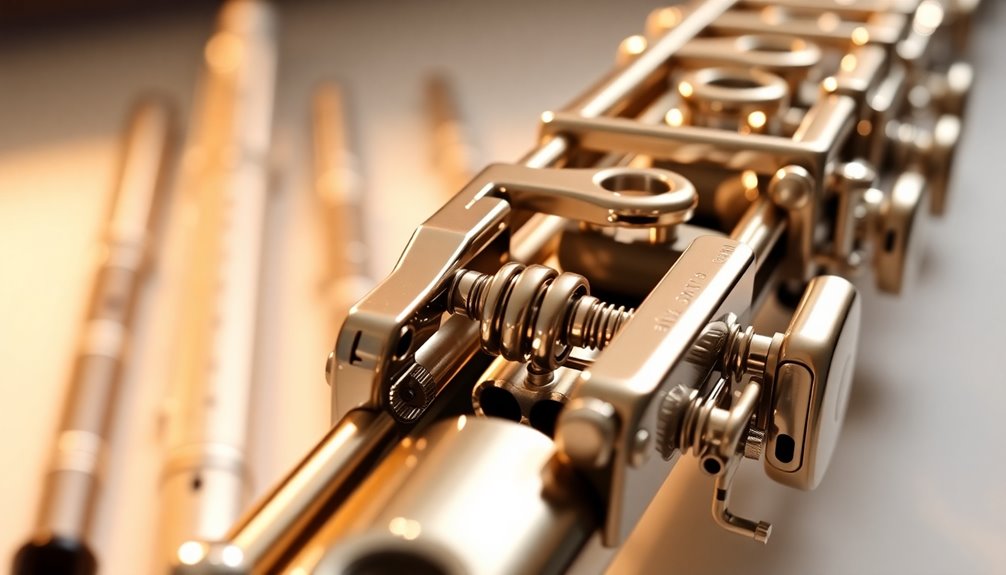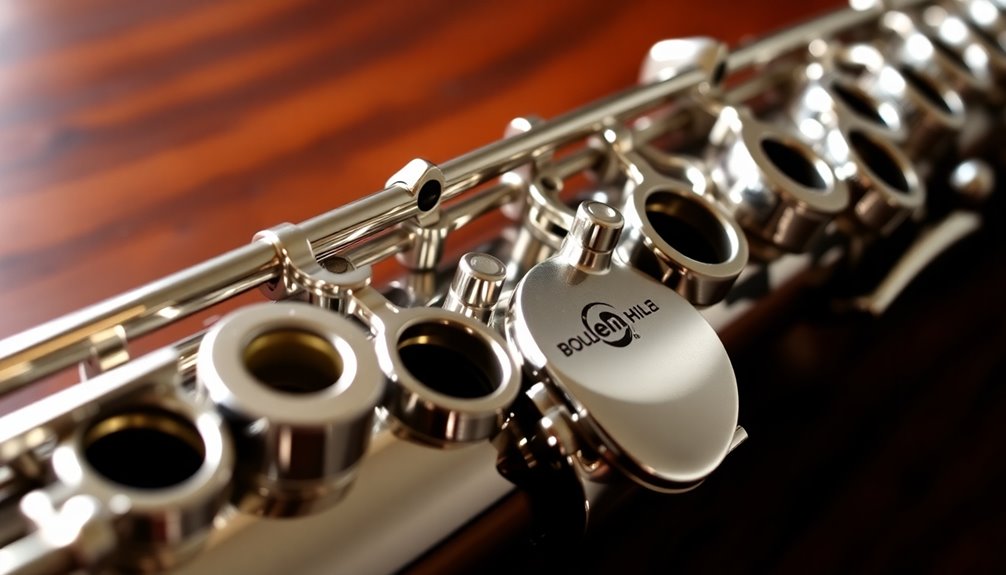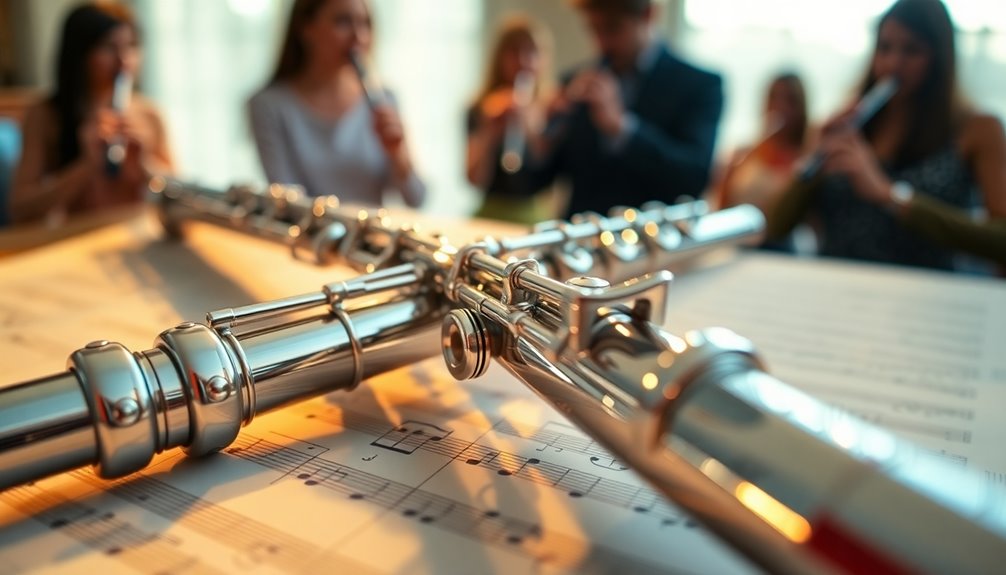Boehm's revolutionary invention of the modern flute transformed both its design and the performance abilities of flutists. By reimagining key placements and using advanced materials like silver and gold, he enhanced the instrument's tonal quality and expressiveness. His systematic approach reduced hand movement, allowing for greater agility in playing complex passages. Additionally, his innovations democratized flute playing, making it more accessible to diverse musicians. As a result, the modern flute supports various musical genres while fostering a thriving community of players. To grasp the full impact of these innovations, you'll discover further insights about their legacy.
Key Takeaways
- Theobald Boehm revolutionized flute design in the 19th century, enhancing range, tonal quality, and playability through innovative key mechanisms and ergonomic placements.
- Boehm's flute featured a systematic arrangement of keys, reducing hand movement and enabling musicians to navigate complex passages more easily.
- His shift from wooden to metal flutes improved sound projection and durability, significantly enhancing the instrument's overall performance.
- Boehm's design democratized flute playing, making it more accessible to a wider range of musicians and fostering a vibrant community of flutists.
- The impact of Boehm's innovations is evident in modern flutes, which support diverse musical genres and encourage artistic expression.
Historical Context of Flute Design

The historical context of flute design reveals a rich interplay of cultural influences and technological advancements that shaped this instrument into what we perceive today. From ancient flutes found in various cultures, you can trace how music has always played a crucial role in human connection. These early instruments, crafted from materials like wood, bone, and later, metal, weren't merely tools for entertainment; they held deep cultural significance, often used in rituals, celebrations, and storytelling.
As societies evolved, so did their flutes. For instance, in ancient China, the dizi emerged, showcasing intricate craftsmanship and a unique sound. Similarly, the Native American flute, with its spiritual undertones, reflects the profound relationship between music and identity. Each variation symbolizes a community's values and beliefs, demonstrating how the flute transcends mere sound production.
The technological advancements in materials and design, especially during the Renaissance and Baroque periods, further enhanced the flute's capabilities. Innovations, such as the addition of keys, allowed for greater expressiveness and versatility, broadening its appeal across genres and cultures. The development of the Boehm system revolutionized flute playing, providing a more efficient key mechanism and improved intonation.
This evolution not only enriched the music world but also fostered a sense of belonging among flute players, uniting them through shared traditions and experiences.
Comprehending this historical context empowers you to appreciate the modern flute in a new light. It's more than an instrument; it's a legacy of human creativity and connection, resonating through centuries of cultural significance.
Theobald Boehm: A Brief Biography

A pivotal figure in the development of the modern flute, Theobald Boehm revolutionized the instrument's design in the 19th century. Born in 1794 in Munich, Germany, Boehm grew up in a musical family, which laid the groundwork for his lifelong passion. His early influences included renowned musicians and composers, who guided his understanding of music and instrument construction, shaping his unique perspective on the flute.
Boehm's education was extensive, encompassing not only music but also engineering principles, which would later play an essential role in his innovations. He studied at the Royal Conservatory in Munich, where he honed his skills as a flutist and developed an appreciation for the technical aspects of instrument design. This combination of performance and technical knowledge became a hallmark of his work.
In his early career, Boehm performed with various orchestras and gained recognition for his virtuosic playing. However, his dissatisfaction with the limitations of the existing flute led him to experiment with its design. He meticulously analyzed the acoustics and mechanics of the instrument, seeking to enhance its range and tonal quality. The advancements in design during the Baroque period ultimately culminated in his groundbreaking system, which transformed flute playing and established new standards for future generations.
Boehm's contributions extended beyond just the flute itself; his insights influenced the broader field of woodwind instrument design. Through his dedication and innovation, he created a legacy that continues to resonate within the music community today.
Innovations in Key Mechanism

Boehm's dissatisfaction with the limitations of existing flutes led him to revolutionize the key mechanism, fundamentally changing how musicians interact with the instrument. He recognized that conventional key placement often resulted in awkward fingerings, which hindered a player's ability to perform fluidly. By reimagining the design of the flute, Boehm introduced a more efficient key mechanism that allowed for greater agility and comfort during play.
One of his key innovations was the systematic arrangement of the keys. He positioned them in such a way that they corresponded more intuitively to finger placement, reducing the need for excessive hand movement. This careful attention to key placement not only enhanced the player's ergonomic experience but also allowed for faster shifts between notes, making complex passages more accessible.
Boehm also focused on increasing mechanism efficiency. By utilizing a more standardized approach to the construction and alignment of the keys, he minimized the mechanical resistance that flutists faced. This meant that players could achieve cleaner, more precise notes with less effort, ultimately leading to a more expressive performance.
These innovations didn't just enhance technical proficiency; they created a sense of belonging within the musical community. Musicians could now explore a wider range of repertoire and express their artistry without being constrained by their instrument. Additionally, Boehm's design paved the way for beginner flutes that are more accessible and user-friendly for new players.
Boehm's advancements in the key mechanism truly transformed the flute into a more responsive and versatile instrument, inviting players of all levels to engage with music in new and exciting ways.
Acoustic Enhancements and Materials

With the evolution of the flute's design, acoustic enhancements became crucial in achieving a richer sound quality. You'll notice that the materials used in modern flutes greatly influence their acoustic properties. Traditionally, flutes were crafted from wood, but the shift to metal—particularly silver and gold—has transformed their sound projection capabilities. These metals not only provide durability but also contribute to a brighter, more focused tone, allowing for greater resonance.
The choice of acoustic materials extends beyond the body of the flute. The pads, springs, and even the cork used in the mechanism all play essential roles in shaping the instrument's overall sound. For instance, felt pads can absorb vibrations, while harder materials can enhance clarity and articulation. Each component interacts intricately, affecting how sound waves travel through the instrument.
Moreover, the internal structure of the flute, including the bore size and shape, has been refined to optimize sound projection. By adjusting these dimensions, you can achieve different tonal qualities, catering to various musical styles. This meticulous attention to detail reflects a deep understanding of acoustics and the desire to create an instrument that resonates with players and audiences alike.
In addition, the use of high-grade stainless steel options has become popular in modern flute designs, enhancing both durability and sound integrity. As you explore modern flutes, consider how these advancements in acoustic materials and design not only enhance playability but also foster a sense of connection among musicians, allowing you to express your artistry more fully. The journey of the flute, enriched by these innovations, invites you into a community of passionate players and listeners.
Impact on Flute Performance

The advancements in acoustic materials and design have had a profound impact on flute performance, influencing not only how the instrument sounds, but also how musicians approach playing it.
With Boehm's design, flutists have experienced a remarkable technique evolution, allowing for a greater range of expression and precision. This evolution has sparked a transformation in performance styles, as musicians can now explore new areas of creativity and interpretation.
As you explore this world, you'll notice several key changes in your approach:
- Enhanced agility: The improved key mechanism facilitates faster finger movements, making it easier to execute intricate passages.
- Expanded tonal palette: The variety of materials and design refinements enable you to produce a wider range of tones, from ethereal whispers to bold, resonant blasts.
- Dynamic control: With advancements in flute design, you'll find it simpler to achieve subtle dynamics and expressive nuances, enriching your performances.
- Broader repertoire: The modern flute's capabilities encourage composers to write more complex and varied pieces, inviting you to explore diverse musical styles.
As you embrace these enhancements, you'll notice how they influence not just your technical proficiency but also your artistic expression. Additionally, many beginners benefit from choosing brands like Yamaha Flutes, which are known for their reliability and ease of play.
The evolution of flute technique and performance styles has created a community where you can share experiences, ideas, and inspiration. In this environment, you're not just a player; you're part of a legacy that continues to evolve and inspire future generations of flutists.
Legacy of Boehm's Design

Few innovations have shaped the modern flute as considerably as the design introduced by Theobald Boehm. His revolutionary approach not only transformed the instrument's structure but also set a new standard for flute playing. Boehm's influence is evident in every aspect of the flute's evolution, from its ergonomic key placements to its improved tonal quality. By aligning the keys in a more logical manner, Boehm made it easier for flutists to navigate complex passages, fostering a new wave of musical expression.
As you explore the legacy of Boehm's design, you'll notice that it encouraged broader participation in flute playing. The enhanced playability made the instrument more accessible, drawing in a diverse array of musicians. This democratization of the flute ultimately paved the way for a greater variety of musical styles and genres, enriching our collective cultural landscape.
Moreover, Boehm's innovations laid the groundwork for future advancements in flute construction. Manufacturers began to adopt his principles, creating instruments that allowed for greater precision and versatility. In fact, the sound quality of modern flutes has been greatly enhanced through these advancements.
Today, when you pick up a modern flute, you're engaging with a product deeply rooted in Boehm's vision.
In understanding Boehm's legacy, you recognize that it's not just about the instrument itself but also about the community of players it has fostered. His design choices resonate through time, inviting you to join in a rich tradition while continuously pushing the boundaries of what's possible in flute performance.
The Modern Flute Today

Boehm's design set the stage for the modern flute, which today reflects a blend of tradition and innovation. You'll find that the modern flute has evolved markedly, incorporating advanced materials and techniques that enhance its sound and playability. This evolution allows flutists to explore a diverse range of musical styles and contemporary flute repertoire that pushes the boundaries of what the instrument can achieve.
Here are some key aspects of modern flute technology:
- Materials: Today's flutes are often made from silver, gold, or even platinum, allowing for richer tonal qualities.
- Key Mechanisms: Innovations in key design improve ergonomics, making it easier for you to play complex passages with fluidity.
- Intonation: Modern flutes are engineered for better intonation, ensuring that each note rings true, whether in solo performances or ensemble settings.
- Customization: Many manufacturers offer customization options, allowing you to tailor your instrument to your unique playing style.
As you navigate the contemporary flute repertoire, you may discover works that challenge both your technical skills and interpretive abilities.
The modern flute's versatility means it can shine in various genres, from classical and jazz to world music. This adaptability not only fosters a sense of belonging within different musical communities but also invites you to express your individuality as a flutist. Additionally, many flutists today are embracing best-selling flutes that cater to their specific needs and preferences.
Ultimately, the modern flute today stands as a reflection of the ongoing dialogue between tradition and innovation.
Frequently Asked Questions
What Materials Are Modern Flutes Typically Made From?
Modern flutes are typically crafted from various flute materials, including silver, gold, and platinum, which provide a rich tonal quality.
Many flutes also use metal alloys, such as nickel-silver, for durability and affordability.
You'll find that these materials influence the instrument's sound and responsiveness.
As you explore different flutes, consider how each material affects your playing experience, helping you find the perfect match that resonates with your musical style and aspirations.
How Does the Boehm Flute Differ From Earlier Flutes?
When it comes to flute design, the Boehm flute's key design features set it apart from earlier models.
You'll notice its larger tone holes and a more efficient key system, which improve intonation and range.
Historically significant, this innovative approach transformed flute playing, allowing for greater expressiveness and technicality.
What Famous Flutists Use Boehm's Design Today?
Today, many famous flutists embrace Boehm's design, showcasing its versatility in their performances.
You'll find it featured in prestigious flute competitions, as artists like Jean-Pierre Rampal and James Galway highlight its brilliance.
Their mastery of the Boehm system not only elevates their sound but also inspires emerging flutists to adopt this innovative design.
Can Beginners Benefit From Playing a Boehm Flute?
Absolutely, beginners can gain significant advantages from playing a Boehm flute.
This design enhances flute accessibility, making it easier for you to produce sound and navigate fingerings. The key system allows for smoother shifts between notes, which can boost your confidence as you learn.
Plus, the ergonomic layout reduces strain on your hands, enabling longer practice sessions. Embracing the Boehm system not only fosters your skills, but also connects you to a vibrant community of flutists.
Are There Any Alternatives to the Boehm System Flute?
You might be surprised to discover that plenty of alternatives to the Boehm system flute exist.
Historical flute variations, like the Baroque or Classical flutes, offer unique timbres and playing experiences.
Each alternative has distinct fingerings and mechanics, which can enrich your musical journey.
Exploring these systems could deepen your appreciation for flute playing and connect you with a broader community of musicians who celebrate diverse styles and traditions.
Conclusion
At its core, Boehm's revolutionary design transformed the flute into a finely tuned instrument, much like a skilled chef refining a recipe to perfection. Just as a chef balances flavors, Boehm balanced acoustics and mechanics, allowing players today to express their artistry with clarity and precision. As you explore the modern flute, remember that each note you play resonates with the legacy of innovation, bridging centuries of musical evolution and inviting you to contribute your voice to this ongoing story.






